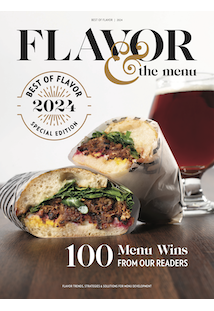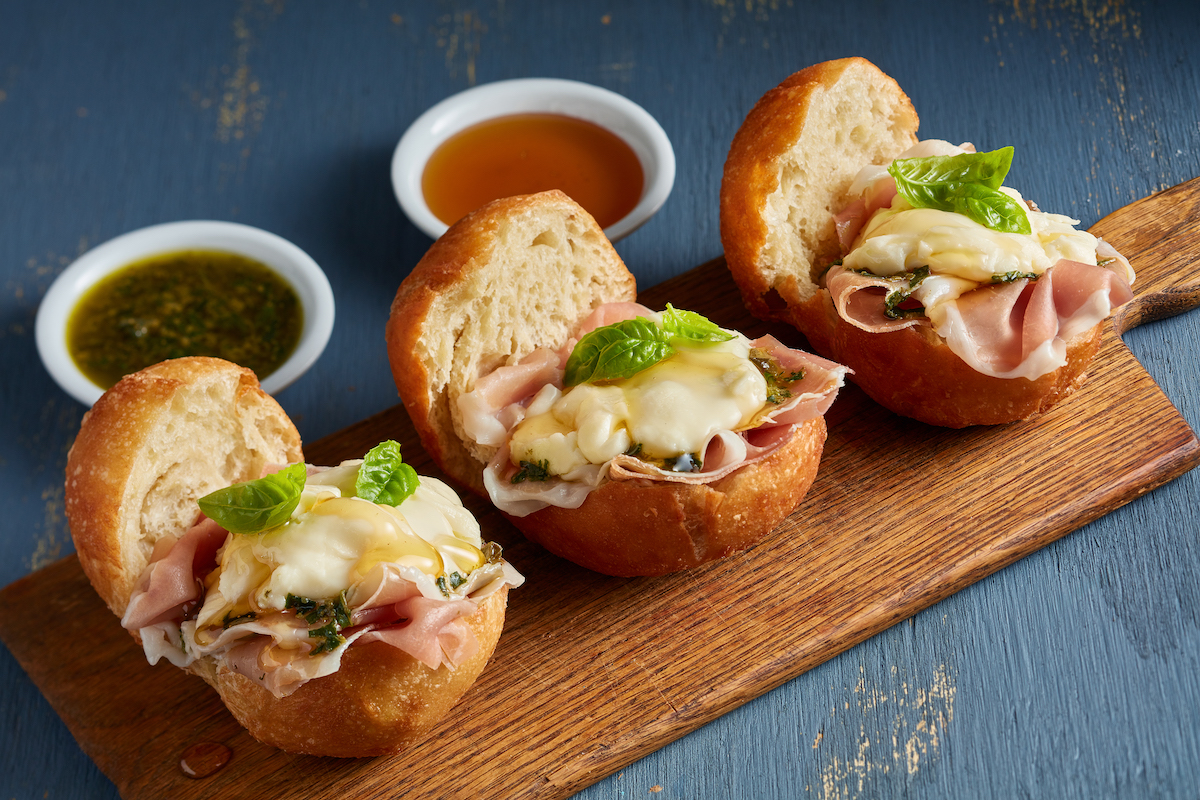


Brian Brindza
Director of Culinary and Menu Innovation
Toppers Pizza
Kitchen Collaborative is a recipe-development initiative formed by Summit F&B and Flavor & The Menu. To fuel flavor innovation, a group of talented chefs partnered with sponsor brands and commodity boards to create recipes that showcase the passion and potential of our industry.
Creativity. Curiosity. A passion for pushing culinary boundaries. These are the primary drivers that ignite Brian Brindza in his recipe ideation work, as he seeks to respond to “the increasing globalization and cultural exchange happening in the culinary world.”
Brindza, Director of Culinary and Menu Innovation at Toppers Pizza, has relished the opportunity to travel to more than 45 countries. “Each has been a culinary adventure, offering me invaluable firsthand experiences that I draw inspiration from,” he notes. “From eating balut in the depths of a Vietnamese jungle to indulging in fresh uni at Tokyo’s bustling Tsukiji market or relishing a camel burger by the Nile River, each encounter has left an indelible mark on my culinary journey.”
The chef recognizes the opportunity and responsibility to use food as a means of cultural exchange, further bringing the world closer together. Brindza recounts meeting a Thai street food vendor. “Despite the language barrier, we connected through our shared love of food. As I explained—with a tiny Thai language book in hand—that I was a chef eager to explore the cuisine, her eyes sparkled with excitement. She became my guide and friend, showcasing her culinary expertise with pride and enthusiasm. It was a beautiful exchange of culture through cuisine.”
Today, he says each dish he creates is, at some level, a reflection of those immersive encounters, including his recipes for Kitchen Collaborative: Coccoli Stracchino, Khao Soi with Barilla® Cellentani and Wild Honey Butter Board.
Coccoli Crescenza-Stracchino™
“My first encounter with coccoli was during my culinary studies abroad in Florence, Italy,” recounts Brindza. “Walking through the charming little side streets of the city, I stumbled upon this delightful street food. The aroma of freshly fried dough wafted through the air, drawing me to the small food stall where coccoli was being prepared. I was hooked with the first bite. The crispy exterior gave way to a soft, fluffy interior, and I enjoyed them with various toppings, from creamy stracchino cheeses to savory prosciutto and even drizzles of sweet honey. One spot I visited would use mortadella.” Back home, the chef experimented with different dough recipes, eventually succeeding in replicating the delicious treat for friends and family.
Fast-forward to today and the chef’s desire to give the dish an elevated spin for Kitchen Collaborative. His Coccoli Stracchino features BelGioioso® Crescenza-Stracchino™. “I knew the flavor would be the same that I experienced in Italy so many years ago,” he says. In this recipe, the fried dough balls are paired with cheese and fresh basil pesto, along with prosciutto and truffle honey. “I think that coccoli can be so much more than what you find in Italy,” Brindza says of his enhancements. “They are so rooted in tradition there that they sometimes don’t realize the opportunities.” In addition to these signature flourishes, he suggests other riffs, such as fresh thyme, pomodoro sauce, Maldon salt and even gelato.
Coccoli can be served stuffed or composed in layers. “Usually, they get rolled up and eaten in a quick bite,” he says. “But some people keep the ingredients on top; others like to build a sandwich and stuff it. But in the end, it’s all really good.” Serve them as a starter or a late-night bar bite, he suggests. “I’d even eat this as a main dish for lunch.”
Khao Soi with Barilla® Cellentani
The origins of this Khao Soi with Barilla® Cellentani extend back to a time when Brindza worked in Thailand as executive innovation chef for a food manufacturer and was inspired to combine elements of both Italian and Thai cuisines. “While traditional Thai dishes often use rice noodles, I was intrigued by the idea of incorporating pasta to offer a fresh twist,” he explains. Today, he finds “the Barilla® Cellentani provided the perfect canvas for experimenting with Thai flavors. Its firm texture and ability to hold sauces well make it an ideal choice for absorbing the vibrant flavors of Khao Soi ingredients like lemongrass, chile and coconut milk.”
The chef says he wants to challenge the perception of pasta as solely an Italian ingredient and showcase its adaptability in global cuisines. “I aimed to create a dish that would surprise and delight with its harmonious blend of flavors from both culinary traditions.”
One significant departure from traditional approaches to this dish is the Cellentani noodle’s corkscrew shape. “It traps and holds onto the delicious Thai-inspired sauce, ensuring that each bite is packed with an explosion of flavor,” says Brindza. “The first sensation to hit the palate will likely be a burst of tanginess, courtesy of lemongrass and lime juice. This is quickly followed by a subtle sweetness from the coconut milk, balanced perfectly by the savory notes of the Thai spices and herbs. As guests continue to savor the dish, the creaminess of the coconut milk will coat their palate, providing a lovely texture that complements the firmness of the pasta. They’ll also encounter hints of spiciness from the chile peppers, adding a delightful kick to each bite.”
As American diners continue to embrace curry-based dishes—thanks to boundless curiosity, greater availability of ingredients and culinary spotlights on social media and television—Brindza is confident that global mash-ups like this fresh spin on Khao Soi will also find favor. “I believe reactions will be overwhelmingly positive to the unique fusion of flavors and textures in this unexpected dish.”
Wild Honey Butter Board
“The butter board trend has certainly made a splash in culinary culture, and it’s easy to see why,” says Brindza. “It celebrates this culinary cornerstone ingredient, elevating it and making it the star of the table.” Presented on beautiful, natural materials like wood, marble or slate, butter boards provide an elegant, but entirely fun, social dining experience.
In this Wild Honey Butter Board, he covers a half-inch layer of unsalted butter with a scattering of wild clover honey, chopped clover honeycomb, crushed toasted pistachios, pomegranate seeds, fresh thyme and Maldon salt. Slices of toasted French bread carry each bite. “Honey’s natural sweetness and butter’s rich creaminess create a harmonious pairing that’s reminiscent of classic combinations like peanut butter and jelly,” says Brindza. “The honey-butter duo is beloved for good reason; they balance each other perfectly.”
The chef selected wild clover honey for its delicate, floral flavor profile. “It has hints of sweetness and mild herbal notes, without being particularly strong or overpowering,” he explains. “It also adds an aromatic complexity to dishes.” The chef also finds the wild clover varietal a good complement to the toasted pistachios and thyme. “The nuttiness of the toasted pistachios adds a rich and earthy contrast to the floral sweetness of the honey, creating a well-rounded flavor experience. Meanwhile, the aromatic notes of thyme enhance the herbal undertones of the clover honey.” And while the pomegranate seeds add a vibrant pop of color to the board, Brindza also cites arils’ sweet-tart flavor and chewy texture as a good contrast for the creamy richness of the butter and floral sweetness of the honey. “It’s like a spring walk in a botanical garden,” he says.
Brindza encourages fellow chefs to explore other honey varietals in butter board applications:
- Orange Blossom Honey: With citrusy and floral notes, it can add a bright and refreshing twist to the butter board, pairing well with toasted almonds, rosemary and citrus zest.
- Lavender Honey: It offers a delicate floral aroma and a hint of herbal sweetness. It complements the flavors of toasted walnuts, lemon zest and thyme on a butter board.
- Acacia Honey: Known for its light and mild flavor profile, it has a subtle sweet flavor that won’t overpower other ingredients. It pairs well with toasted hazelnuts, vanilla bean and fresh berries.
- Wildflower Honey: This is a versatile option with a complex flavor profile that varies, depending on the specific flowers visited by the bees. It can add depth and richness to the board and works nicely with a wide range of ingredients, including toasted pecans, cinnamon and dried fruit.
- Buckwheat Honey: It boasts a robust, earthy flavor with hints of molasses and malt. It can add depth and complexity to the butter board, especially when paired with ingredients like dark chocolate, espresso or smoked nuts.
Project Management: Summit F&B
Photography: Carlos Garcia // Food Styling: Peg Blackley











